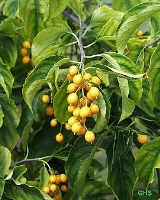
Celastrus scandens
Encyclopedia
Celastrus scandens, commonly called American Bittersweet or Bittersweet, is a species
of staff vine
s that blooms mostly in June and is commonly found on rich, well-drained soils of woodland
s. It has a sturdy perennial vine
that may have twining
, woody stems
that are 30 feet (9.1 m) or longer and an inch or more thick at the base. The stems are yellowish-green to brown and wind around other vegetation
, sometimes killing saplings by restricting further growth. It has tiny, scentless flowers at the tips of the branches. It has colorful, orange fruits that are the size of a pea
. These fruits are poisonous to humans when ingested internally, but are favorites of birds. C. scandens roots were used by Native Americans
and pioneers
to induce vomiting
, to treat venereal disease, and to treat symptoms of tuberculosis
.
C. scandens is native to central and eastern North America. It was given the name Bittersweet by European colonists in the 18th century because the fruits resembled the appearance of the fruits of Eurasian Nightshade (Solanum dulcamara
), which was also called Bittersweet. Today, American Bittersweet is the accepted common name of C. scandens in large part to distinguish it from an invasive relative, C. orbiculatus (Oriental Bittersweet), from Asia.
Species
In biology, a species is one of the basic units of biological classification and a taxonomic rank. A species is often defined as a group of organisms capable of interbreeding and producing fertile offspring. While in many cases this definition is adequate, more precise or differing measures are...
of staff vine
Staff vine
The staff vines, also known as staff trees or bittersweet, genus Celastrus, comprise about 30 species of shrubs and vines. They have a wide distribution in East Asia, Australasia, Africa and the Americas....
s that blooms mostly in June and is commonly found on rich, well-drained soils of woodland
Woodland
Ecologically, a woodland is a low-density forest forming open habitats with plenty of sunlight and limited shade. Woodlands may support an understory of shrubs and herbaceous plants including grasses. Woodland may form a transition to shrubland under drier conditions or during early stages of...
s. It has a sturdy perennial vine
Vine
A vine in the narrowest sense is the grapevine , but more generally it can refer to any plant with a growth habit of trailing or scandent, that is to say climbing, stems or runners...
that may have twining
Twining
-Places:In the United States:*Twining, Michigan, a village*Twining, Washington, D.C., a neighborhood-Other uses:*A type of basket weaving*Plants growing upwards by revolving around and leaning on a supporting structure. They are neither climbing, nor freely upright.*Twining Models, an English...
, woody stems
Plant stem
A stem is one of two main structural axes of a vascular plant. The stem is normally divided into nodes and internodes, the nodes hold buds which grow into one or more leaves, inflorescence , conifer cones, roots, other stems etc. The internodes distance one node from another...
that are 30 feet (9.1 m) or longer and an inch or more thick at the base. The stems are yellowish-green to brown and wind around other vegetation
Vegetation
Vegetation is a general term for the plant life of a region; it refers to the ground cover provided by plants. It is a general term, without specific reference to particular taxa, life forms, structure, spatial extent, or any other specific botanical or geographic characteristics. It is broader...
, sometimes killing saplings by restricting further growth. It has tiny, scentless flowers at the tips of the branches. It has colorful, orange fruits that are the size of a pea
Pea
A pea is most commonly the small spherical seed or the seed-pod of the pod fruit Pisum sativum. Each pod contains several peas. Peapods are botanically a fruit, since they contain seeds developed from the ovary of a flower. However, peas are considered to be a vegetable in cooking...
. These fruits are poisonous to humans when ingested internally, but are favorites of birds. C. scandens roots were used by Native Americans
Indigenous peoples of the Americas
The indigenous peoples of the Americas are the pre-Columbian inhabitants of North and South America, their descendants and other ethnic groups who are identified with those peoples. Indigenous peoples are known in Canada as Aboriginal peoples, and in the United States as Native Americans...
and pioneers
American pioneer
American pioneers are any of the people in American history who migrated west to join in settling and developing new areas. The term especially refers to those who were going to settle any territory which had previously not been settled or developed by European or American society, although the...
to induce vomiting
Vomiting
Vomiting is the forceful expulsion of the contents of one's stomach through the mouth and sometimes the nose...
, to treat venereal disease, and to treat symptoms of tuberculosis
Tuberculosis
Tuberculosis, MTB, or TB is a common, and in many cases lethal, infectious disease caused by various strains of mycobacteria, usually Mycobacterium tuberculosis. Tuberculosis usually attacks the lungs but can also affect other parts of the body...
.
C. scandens is native to central and eastern North America. It was given the name Bittersweet by European colonists in the 18th century because the fruits resembled the appearance of the fruits of Eurasian Nightshade (Solanum dulcamara
Solanum dulcamara
Solanum dulcamara, also known as bittersweet, bittersweet nightshade, bitter nightshade, blue bindweed, Amara Dulcis, climbing nightshade, fellenwort, felonwood, poisonberry, poisonflower, scarlet berry, snakeberry, trailing bittersweet, trailing nightshade, violet bloom, or woody...
), which was also called Bittersweet. Today, American Bittersweet is the accepted common name of C. scandens in large part to distinguish it from an invasive relative, C. orbiculatus (Oriental Bittersweet), from Asia.

